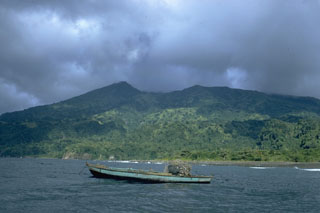Report on Soufriere St. Vincent (Saint Vincent and the Grenadines) — 16 March-22 March 2022
Smithsonian Institution / US Geological Survey
Weekly Volcanic Activity Report, 16 March-22 March 2022
Managing Editor: Sally Sennert.
Please cite this report as:
Global Volcanism Program, 2022. Report on Soufriere St. Vincent (Saint Vincent and the Grenadines) (Sennert, S, ed.). Weekly Volcanic Activity Report, 16 March-22 March 2022. Smithsonian Institution and US Geological Survey.
Soufriere St. Vincent
Saint Vincent and the Grenadines
13.33°N, 61.18°W; summit elev. 1220 m
All times are local (unless otherwise noted)
UWI Seismic Research Centre and National Emergency Management Organisation (NEMO) lowered the Alert Level for Soufrière St. Vincent to Green (the lowest level on a four-color scale) on 16 March, noting that seismic and fumarolic activity were at or below background levels recorded prior to the 2020-2021 eruption. The La Soufriere trail remained closed due to the uneven and dangerous terrain. The public was reminded about lahar hazards during heavy rains.
Geological Summary. Soufrière St. Vincent is the northernmost and youngest volcano on St. Vincent Island. The NE rim of the 1.6-km wide summit crater is cut by a crater formed in 1812. The crater itself lies on the SW margin of a larger 2.2-km-wide caldera, which is breached widely to the SW as a result of slope failure. Frequent explosive eruptions after about 4,300 years ago produced pyroclastic deposits of the Yellow Tephra Formation, which cover much of the island. The first historical eruption took place in 1718; it and the 1812 eruption produced major explosions. Much of the northern end of the island was devastated by a major eruption in 1902 that coincided with the catastrophic Mont Pelée eruption on Martinique. A lava dome was emplaced in the summit crater in 1971 during a strictly effusive eruption, forming an island within a lake that filled the crater. A series of explosive eruptions in 1979 destroyed the 1971 dome and ejected the lake; a new dome was then built.
Sources: University of the West Indies Seismic Research Centre (UWI-SRC), National Emergency Management Organisation (NEMO), Government of Saint Vincent and the Grenadines

